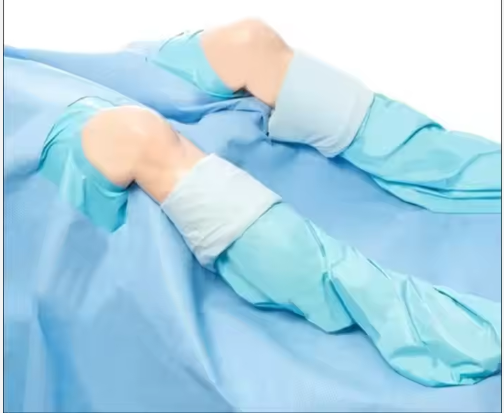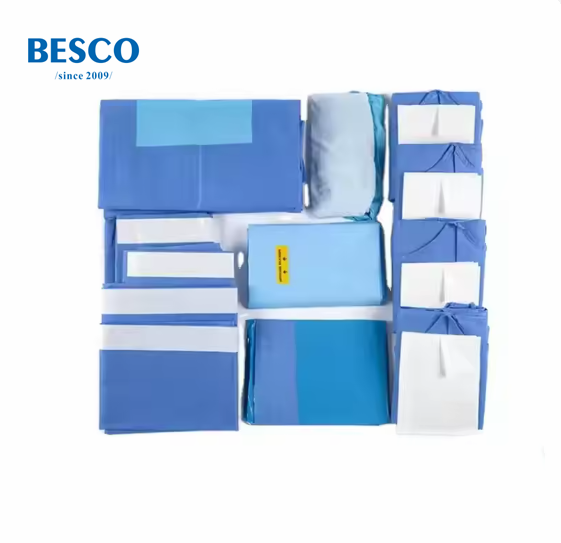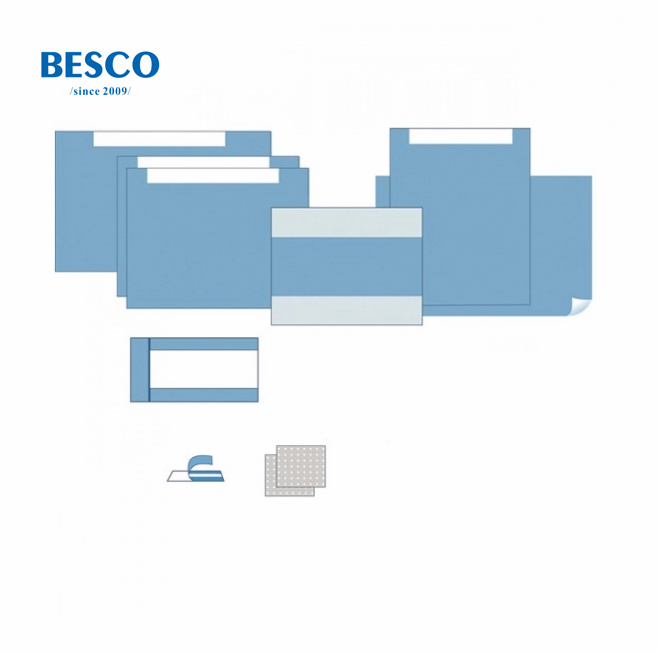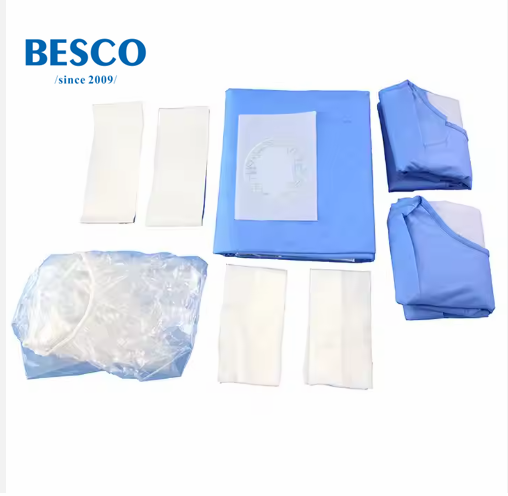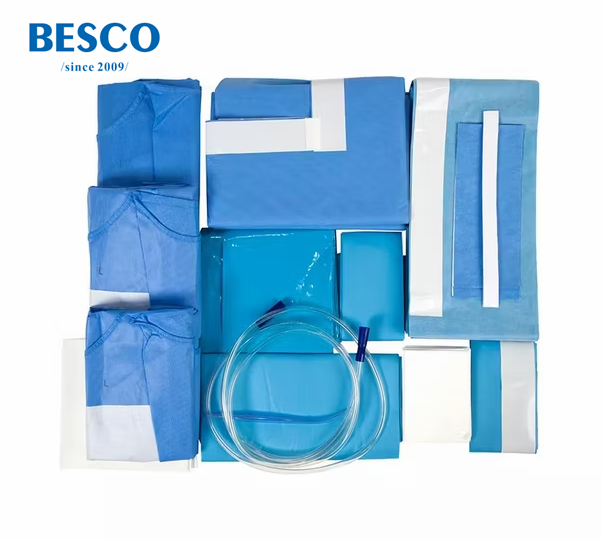| Name: | Urology Medical Packs |
|---|---|
| Product Name: | Urology Medical Packs |
| Material: | SMS |
| Brand: | BESCO |
| Keywords: | Urology Medical Packs,Urology Surgical Packs,Urology Surgery Kits |
| MOQ: | 500 packs |
| Price: | US7.95 |
| Lead time: | 7 days |
| SAMPLES: | Available |
| Payment Term: | T/T in advance |
| Country of Original: | China |
| Stock: | Available |
| Port: | Qingdao |
| Factory Address: | Changyuan,China |
Products Description
Specifications:
Hand towel | 30*40cm | 2 | 45g |
surgical gown | L(125*145cm) | 2 | 45g sms |
Mayo stand cover | 75*145cm | 1 | 40g PE+40g PP |
T.U.R. Drape | 240*290*80cm | 1 | 45g sms |
Back table cover | 150*190cm | 1 | 30g PE +30g PP |
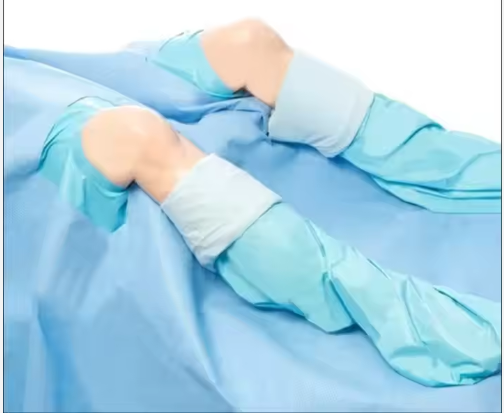

Urology medical packs are specialized kits designed for urological procedures and surgeries. They contain essential instruments and supplies needed for diagnosis, treatment, and surgical interventions related to the urinary tract and male reproductive system.
Contents of Urology Medical Packs:
Instruments: Common tools include scalpels, forceps, scissors, and dilators.
Supplies: Sterile drapes, gloves, and sutures are typically included.
Consumables: Catheters, irrigation solutions, and antiseptics may also be part of the pack.
Types of Urology Packs:
Diagnostic Packs: Used for procedures like cystoscopy.
Surgical Packs: Designed for surgeries such as prostatectomy or nephrectomy.
Emergency Packs: Prepared for urgent urological interventions.
These packs streamline the preparation process for healthcare providers, ensuring that all necessary items are readily available and sterile. They are crucial in maintaining efficiency and safety in urological care.
How to use urology medical packs (Focusing on urinary drainage bags and accessories)?
Urology medical packs typically contain items for managing urinary function, especially when using a urinary catheter. Here's a breakdown of how to use common items like drainage bags and related accessories found in such packs:
1. Urinary drainage bags
Purpose: Collect urine drained from a catheter.
Types:
Leg bags (small): Designed for daytime use and attach to your thigh or calf. They are discreet and allow for movement.
Night bags (large): Have a larger capacity for overnight use, minimizing the need to empty during the night.
Placement (both types): Always keep the bag positioned below the bladder or hips to ensure proper drainage and prevent urine reflux back into the bladder.
Emptying leg bags: Empty when ½ to ⅔ full (or as instructed by your doctor) to prevent overfilling and potential complications.
Wash hands thoroughly before and after.
Hold the bag over a toilet or designated container.
Open the spout or valve at the bottom of the bag to drain urine.
Avoid touching the spout to prevent contamination.
Clean the spout with rubbing alcohol if recommended.
Close the spout securely and reattach the bag if using a leg bag.
Do not place the bag on the floor.
Changing drainage bags (leg to night and vice-versa):
Wash hands and gather supplies (alcohol pads, new bag).
Empty the urine from the current bag.
Place a towel or gauze under the catheter connection.
Pinch off the catheter tubing to prevent leakage.
Disconnect the current bag with a twisting motion.
Clean the end of the catheter and the new bag's connector with alcohol pads.
Attach the new bag by inserting the tubing into the connector.
Check for kinks or twists in the tubing and wash hands.
2. Catheters
Placement: Inserted into the urethra and bladder to drain urine.
Care:
Maintain good hygiene around the catheter insertion site.
Avoid pulling or tugging on the catheter tubing.
Ensure the tubing has some slack to avoid pressure on the urethra or bladder.
Arrange the tubing to avoid kinks or twists.
If using a leg bag, secure it comfortably and ensure the catheter creates a gentle "S" shape, not a straight line.
Regularly check for signs of infection (redness, swelling, pain) or leakage, and contact your healthcare provider if these occur.
3. Other urological supplies (potentially included in packs)
Insertion Trays: Contain items like lubricant, swabs, gloves, and specimen containers to facilitate catheter insertion.
Irrigation Trays: Used to flush out the catheter and may contain syringes, drapes, and alcohol wipes.
Skin Barriers/Sealants/Ointments: Protect the skin around the catheter insertion site or urostomy from irritation.
Catheter Leg Straps & Holders: Help secure leg bags comfortably and prevent tugging or pulling on the catheter.
Important safety notes:
Always follow the specific instructions provided by your healthcare provider and the product manufacturer for proper use, cleaning, and disposal of all urological supplies.
Prioritize hygiene: Wash hands thoroughly before and after handling any urological devices.
Seek professional guidance: Don't hesitate to consult your doctor or healthcare provider if you have any questions or concerns about using urological products or experience any problems.
Proper disposal: Regulated medical waste like used catheters and drainage bags should be disposed of in designated biohazard containers (red bags are common). Dispose of sharps in appropriate sharps containers. Ensure proper labeling and follow local regulations for medical waste disposal.
By carefully following these steps and maintaining good hygiene practices, you can safely and effectively manage your urinary health with urology medical packs.
